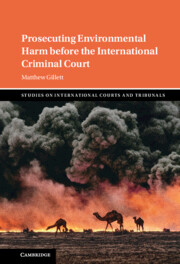Throughout history, armed conflicts have frequently seen serious harm committed against the natural environment. From the early 1960s to 1971, the United States used Agent Orange to defoliate large tracts of Vietnamese forests. In the 1990s, Saddam Hussein vengefully ordered the burning of Kuwaiti oil wells, resulting in massive pollution to the air, land and surrounding seas. More recently, ecocentric harm has been documented in the Colombian civil war, by the so-called Islamic State group, and in the Ukraine conflict, among others. Whilst international humanitarian law (IHL) contains several prohibitions against environmental harm, the most striking is Article 55(2) of Additional Protocol I, whereby “[a]ttacks against the natural environment by way of reprisals are prohibited”. Although this provision appears absolute and unconditional, critical questions persist regarding its status under customary international law and its applicability in non-international armed conflicts. Moreover, its criminalization has not been explored in the jurisprudence of international courts or in the relevant scholarly literature, despite the fact that penal sanctions against individuals are an important factor for enforcement of environmental protections.
To fill the lacuna, the following analysis examines the prohibition and criminalization of reprisals against the natural environment. It reviews conventional and customary international law to determine the current status of a putative criminal prohibition and its potential as lex ferenda. Importantly, it also assesses the relevance of reprisals against the natural environment for prosecutions under existing war crimes, such as attacks on civilian objects and destruction of enemy property. It generates novel insights for the application of international law to ecocentric harm, including that (1) reprisals against the natural environment are not criminal per se, but (2) conceptualizing the environment as a civilian object opens up clear paths for prosecuting attacks, including reprisals, against it; (3) the inherently intentional nature of reprisals has far-reaching implications for their prosecution; (4) reprisals can significantly impact the pivotal test of military necessity which arises in criminal prohibitions such as that found in Article 8(2)(b)(iv) of the Rome Statute; and (5) situations of reprisals could impact the application of the proposed definition of ecocide.
Traversing IHL and international criminal law (ICL), the article identifies ways in which these traditionally anthropocentric bodies of law can be reoriented to accommodate ecocentric values. This reconceptualization is significant, as the prospect of criminal sanctions is critical for deterring potential perpetrators and potentially adds a basis for reparations designed to remediate damage to the environment. The assessment redresses the fact that the natural environment has been seen as a peripheral matter under both IHL and ICL and has remained under-explored despite the ongoing destruction wrought on nature including during armed conflict. It seeks to elevate the environment to a core protected value under these legal regimes, as a reflection of our increasing awareness that the natural environment is critical for the well-being of current and future generations and our growing appreciation of the intrinsic importance of protecting nature.




